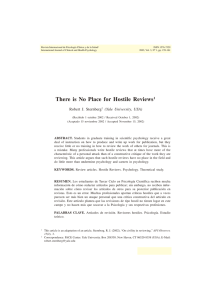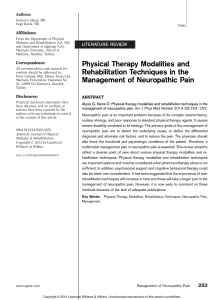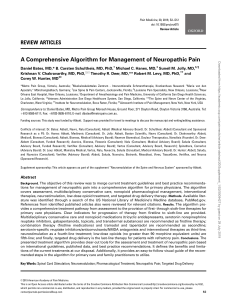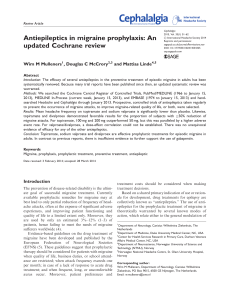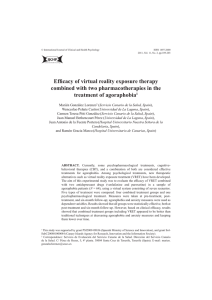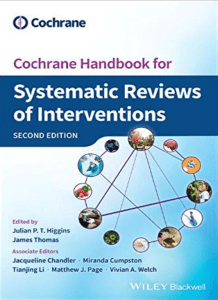Benefits and harms of drugs for “neuropathic” pain
Anuncio
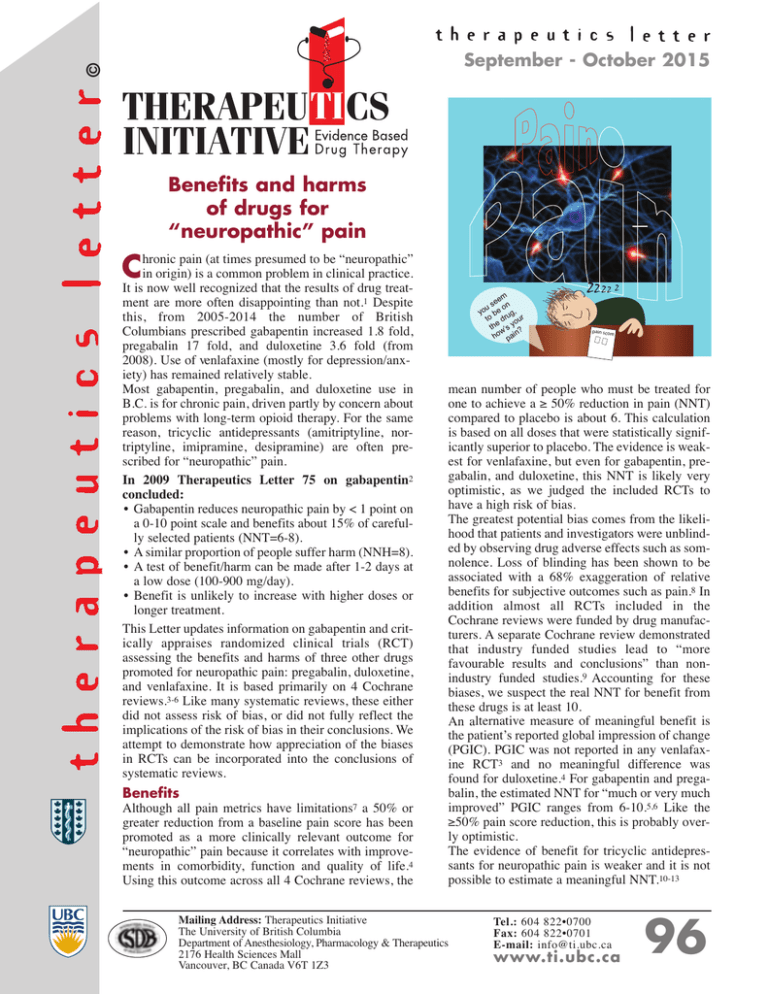
© September - October 2015 Benefits and harms of drugs for “neuropathic” pain hronic pain (at times presumed to be “neuropathic” in origin) is a common problem in clinical practice. C It is now well recognized that the results of drug treatment are more often disappointing than not.1 Despite this, from 2005-2014 the number of British Columbians prescribed gabapentin increased 1.8 fold, pregabalin 17 fold, and duloxetine 3.6 fold (from 2008). Use of venlafaxine (mostly for depression/anxiety) has remained relatively stable. Most gabapentin, pregabalin, and duloxetine use in B.C. is for chronic pain, driven partly by concern about problems with long-term opioid therapy. For the same reason, tricyclic antidepressants (amitriptyline, nortriptyline, imipramine, desipramine) are often prescribed for “neuropathic” pain. In 2009 Therapeutics Letter 75 on gabapentin2 concluded: • Gabapentin reduces neuropathic pain by < 1 point on a 0-10 point scale and benefits about 15% of carefully selected patients (NNT=6-8). • A similar proportion of people suffer harm (NNH=8). • A test of benefit/harm can be made after 1-2 days at a low dose (100-900 mg/day). • Benefit is unlikely to increase with higher doses or longer treatment. This Letter updates information on gabapentin and critically appraises randomized clinical trials (RCT) assessing the benefits and harms of three other drugs promoted for neuropathic pain: pregabalin, duloxetine, and venlafaxine. It is based primarily on 4 Cochrane reviews.3-6 Like many systematic reviews, these either did not assess risk of bias, or did not fully reflect the implications of the risk of bias in their conclusions. We attempt to demonstrate how appreciation of the biases in RCTs can be incorporated into the conclusions of systematic reviews. Benefits Although all pain metrics have limitations7 a 50% or greater reduction from a baseline pain score has been promoted as a more clinically relevant outcome for “neuropathic” pain because it correlates with improvements in comorbidity, function and quality of life.4 Using this outcome across all 4 Cochrane reviews, the m ee u s on yo be ug, to dr our the ’s y ? w ho pain ZZ Z Z Z pain score mean number of people who must be treated for one to achieve a ≥ 50% reduction in pain (NNT) compared to placebo is about 6. This calculation is based on all doses that were statistically significantly superior to placebo. The evidence is weakest for venlafaxine, but even for gabapentin, pregabalin, and duloxetine, this NNT is likely very optimistic, as we judged the included RCTs to have a high risk of bias. The greatest potential bias comes from the likelihood that patients and investigators were unblinded by observing drug adverse effects such as somnolence. Loss of blinding has been shown to be associated with a 68% exaggeration of relative benefits for subjective outcomes such as pain.8 In addition almost all RCTs included in the Cochrane reviews were funded by drug manufacturers. A separate Cochrane review demonstrated that industry funded studies lead to “more favourable results and conclusions” than nonindustry funded studies.9 Accounting for these biases, we suspect the real NNT for benefit from these drugs is at least 10. An alternative measure of meaningful benefit is the patient’s reported global impression of change (PGIC). PGIC was not reported in any venlafaxine RCT3 and no meaningful difference was found for duloxetine.4 For gabapentin and pregabalin, the estimated NNT for “much or very much improved” PGIC ranges from 6-10.5,6 Like the ≥50% pain score reduction, this is probably overly optimistic. The evidence of benefit for tricyclic antidepressants for neuropathic pain is weaker and it is not possible to estimate a meaningful NNT.10-13 Mailing Address: Therapeutics Initiative The University of British Columbia Department of Anesthesiology, Pharmacology & Therapeutics 2176 Health Sciences Mall Vancouver, BC Canada V6T 1Z3 Tel.: 604 822•0700 Fax: 604 822•0701 E-mail: info@ti.ubc.ca www.ti.ubc.ca 96 September - October 2015 Harms Withdrawals due to adverse effects compared with placebo were higher with gabapentin, pregabalin, duloxetine and venlafaxine.3-6 Approximately 80% of people receiving these drugs experienced at least one adverse effect. The most common were somnolence, dizziness, and nausea. Anticholinergic effects, such as dry mouth and constipation, were common with duloxetine. The rate of adverse effects reported in Cochrane reviews almost certainly underestimate the real world rates because patients at higher risk (e.g. from impaired kidney function, alcohol use, or with other morbidities) are excluded from RCTs. Furthermore, official product monographs for these drugs report higher rates of adverse effects than do the Cochrane reviews. The most common adverse effects reported for the tricyclic antidepressants were dry mouth, sedation and constipation.10-13 Likewise official monographs provide a better and higher estimate of the incidence of harms than the systematic reviews. To whom do the Cochrane reviews apply? Patients averaged 50 years of age, had moderate levels of neuropathic pain, and were free of medical conditions other than those being studied (diabetes, fibromyalgia, or post-herpetic neuralgia). RCTs varied with respect to allowed use of other analgesics from acetaminophen only to the use of multiple analgesics including opioids. How soon is pain reduced? In the majority of trials pain reduction compared with placebo was demonstrable within the first week. Very little additional pain reduction occurred after the second week. Clinical implications Evidence from 8 Cochrane reviews should temper expectations regarding the likelihood and magnitude of pain relief from gabapentin, pregabalin, duloxetine, venlafaxine, amitriptyline, nortriptyline, imipramine or desipramine. When initiating a therapeutic trial with one of these drugs in a patient, it is reasonable to start at the lowest recommended dose and assess the patient for benefit and harm at 1 week. If benefit harm ratio is unacceptable, consider stopping the drug. If insufficient but partial pain relief is achieved, increase the dose and reassess within 1 week. If functionally meaningful benefit is still absent, stop the drug and try something else. For patients who achieve clinically meaningful analgesia, use the lowest individualized effective dose to minimize adverse effects. Reassess regularly (e.g. every 2 weeks), as most patients treated with placebo also improve over time. • The evidence base for drug treatment of neuropathic pain is weak, due to the small magnitude of clinically meaningful effects and the high risk of bias in the RCTs. • Probably less than 1 in 10 patients achieve a meaningful reduction in pain. • Most patients experience some adverse side effects like somnolence, dizziness, nausea, dry mouth and constipation. • To identify patients who respond, a therapeutic trial with early assessment is essential. Reassessment of drug utility is needed to detect people with spontaneous remission or placebo response. • Higher doses are unlikely to achieve greater pain reduction, but are more likely to cause harm. Conclusions Is there evidence that increasing dose improves response? For gabapentin, pregabalin, duloxetine and venlafaxine, RCTs demonstrated little or no benefit from doses higher than the lowest dose that was superior to placebo.3-6 References 1. Moore A, Derry S, Eccleston C, Kalso E. Expect analgesic failure; pursue analgesic success. BMJ. 346:f2690, 2013. 2. Therapeutics Initiative. Gabapentin for pain. New evidence from hidden data. Therapeutics Letter. 2009; 75:1-2. 3. Gallagher HC, Gallagher RM, Butler M, et al. Venlafaxine for neuropathic pain in adults. Cochrane Database of Systematic Reviews, 2015 Issue 8. Art. No.: CD011091.DOI: 10.1002/14651858. CD011091.pub2. 4. Lunn MPT, Hughes RAC, Wiffen PJ. Duloxetine for treating painful neuropathy, chronic pain or fibromyalgia. Cochrane Database of Systematic Reviews 2014, Issue 1.Art.No.: CD007115.DOI:10.1002/14651858.CD007115.pub3. 5. Moore RA, Straube S, Wiffen PJ, et al. Pregabalin for acute and chronic pain in adults. Cochrane Database of Systematic Reviews 2009, Issue 3. Art. NO.: CD007076. DOI: 10.1002/14651858.CD007076.pub2. 6. Moore RA, Wiffen PJ, Derry S, et al. Gabapentin for chronic neuropathic pain and fibromyalgia in adults. Cochrane Database of Systematic Reviews, 2014, Issue 4. Art. No.: CD007938. DOI: 10.1002/14651858.CD007938.pub3. 7. Ballantyne JC, Sullivan MD. Intensity of Chronic Pain – The Wrong Metric? N Engl J Med 2015;373(22): 2098-9. 8. Hrobjartsson A, Thomsen AS, Emanuelsson F, et al. Observer bias in randomized clinical trials with measurement scale outcomes: a systematic review of trials with both blinded and nonblinded assessors. CMAJ 2013 Mar 5;185(4):E201-11. 9. Lundh A, Sismondo S, Lexchin J, et al. Industry sponsorship and research outcome. Cochrane Database of Systematic Reviews 2012, Issue 12. Art. No.: MR000033.DOI:10.1002/14651858.MR000033.pub2. 10. Moore RA, Derry S, Aldington D, et al. Amitriptyline for neuropathic pain in adults. Cochrane Database of Systematic Reviews 2015, Issue 7. Art. No.: CD008242. DOI: 10.1002/14651858.CD008242.pub3. 11. Derry S, Wiffen PJ, Aldington D, Moore RA. Nortriptyline for neuropathic pain in adults. Cochrane Database of Systematic Reviews 2015, Issue 1. Art. No.: CD011209. DOI: 10.1002/14651858.CD011209.pub2 12. Hearn L, Moore RA, Derry S, et al. Desipramine for neuropathic pain in adults. Cochrane Database of Systematic Reviews 2014, Issue 9. Art. No.: CD011003. DOI: 10.1002/14651858.CD011003.pub2. 13. Hearn L, Derry S, Phillips T, et al. Imipramine for neuropathic pain in adults. Cochrane Database of Systematic Reviews 2014, Issue 5. Art. No.: CD010769. DOI: 10.1002/14651858.CD010769.pub2. The draft of this Therapeutics Letter was submitted for review to 60 experts and primary care physicians in order to correct any inaccuracies and to ensure that the information is concise and relevant to clinicians. The Therapeutics Initiative is funded by the BC Ministry of Health through a grant to the University of BC. The Therapeutics Initiative provides evidence-based advice about drug therapy, and is not responsible for formulating or adjudicating provincial drug policies. 96

